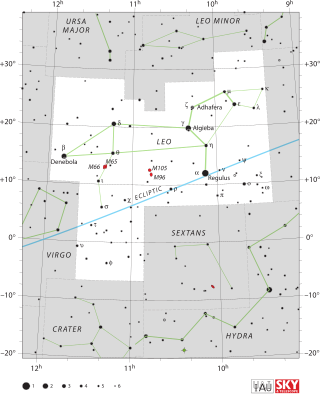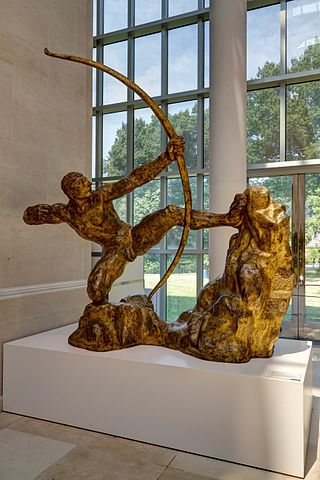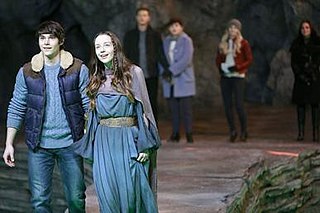Hercules and the Nemean Lion may refer to:
Hercules and the Nemean Lion may refer to:

Leo is one of the constellations of the zodiac, between Cancer the crab to the west and Virgo the maiden to the east. It is located in the Northern celestial hemisphere. Its name is Latin for lion, and to the ancient Greeks represented the Nemean Lion killed by the mythical Greek hero Heracles meaning 'Glory of Hera' as one of his twelve labors. Its old astronomical symbol is (♌︎). One of the 48 constellations described by the 2nd-century astronomer Ptolemy, Leo remains one of the 88 modern constellations today, and one of the most easily recognizable due to its many bright stars and a distinctive shape that is reminiscent of the crouching lion it depicts. The lion's mane and shoulders also form an asterism known as "The Sickle," which to modern observers may resemble a backwards "question mark."

The Nemean lion was a monster in Greek mythology that lived at Nemea. Eventually, it was killed by Heracles (Hercules). Because its golden fur was impervious to attack, it could not be killed with mortals' weapons. Its claws were sharper than mortals' swords and could destroy any strong armour. In Bibliotheca, Photius wrote that the dragon Ladon, who guarded the golden apples, was his brother.

The Nemean Games were one of the four Panhellenic Games of Ancient Greece, and were held at Nemea every two years.

The Mighty Hercules is an animated television series based loosely on the Greek mythology character of Heracles, under his Roman name Hercules. It debuted on television in 1963. The show ran until 1966, coinciding with the sword-and-sandal genre of films popular between 1958 and 1965. Each stand-alone episode runs 5½ minutes, and in syndication was aired either as part of a block with other cartoons, or with several episodes airing consecutively to fill 30-minute time slots.

The Farnese Hercules is an ancient statue of Hercules, probably an enlarged copy made in the early third century AD and signed by Glykon, who is otherwise unknown; the name is Greek but he may have worked in Rome. Like many other Ancient Roman sculptures it is a copy or version of a much older Greek original that was well known, in this case a bronze by Lysippos that would have been made in the fourth century BC. This original survived for over 1500 years until it was melted down by Crusaders in 1205 during the Sack of Constantinople. The enlarged copy was made for the Baths of Caracalla in Rome, where the statue was recovered in 1546, and is now in the Museo Archeologico Nazionale in Naples. The heroically-scaled Hercules is one of the most famous sculptures of antiquity, and has fixed the image of the mythic hero in the European imagination.

Nemea is an ancient site in the northeastern part of the Peloponnese, in Greece. Formerly part of the territory of Cleonae in ancient Argolis, it is today situated in the regional unit of Corinthia. The small village of Archaia Nemea is immediately southwest of the archaeological site, while the new town of Nemea lies to the west.

Leo (♌︎) is the fifth sign of the zodiac. It corresponds to the constellation Leo and comes after Cancer and before Virgo. The traditional Western zodiac associates Leo with the period between about July 23 and August 23, and the sign spans the 120th to 150th degree of celestial longitude.
Hercules is a 2005 American television miniseries chronicling the life of the legendary Greek hero, Heracles, called Hercules in this series. It is most often aired on television as a two-part miniseries: the first part documents his early life in Tiryns and his desire and marriage to the lady Megara; the second part follows the more widely recognised part of his life, in seeking redemption for the madness-induced murder of his family.

Hercules of the Forum Boarium is one of two gilded bronze statues of Hercules found on the site of the Forum Boarium of ancient Rome. The two statues were both placed in the Palazzo Dei Convervatori for safe keeping in 1950 and remain there today. The Hercules of Forum Boarium was likely to have been a cult image of Temple of Hercules that stood by the ancient cattle market.

Hercules the Archer is a sculpture by Antoine Bourdelle, originally made in 1909, which now exists in many versions. It was a commission of the financier and philanthropist Gabriel Thomas, as a single copy in gilt-bronze in April 1909; Bourdelle worked on the sculpture in the summer of 1909. It was cast by Eugène Rudier, and it was exhibited at the National Society of Fine Arts in 1910, and much appreciated. The dimensions were 2.50 m × 2.40 m.
The Herculean Sarcophagus of Genzano is a Roman sarcophagus from Genzano, which is in store at the British Museum. It features the Twelve Labours of Hercules. It has been dated to about AD 150–180. It is 221 cm long, 76 cm high and 91.5 cm wide.

The Legend of Hercules is a 2014 American 3D action fantasy film directed by Renny Harlin, written by Daniel Giat and Sean Hood, and starring Kellan Lutz, Gaia Weiss, Scott Adkins, Roxanne McKee, and Liam Garrigan. It was distributed by Lionsgate and released January 10, 2014, six months before another Hollywood-studio Hercules film, Paramount Pictures' and MGM's co-production Hercules. The Legend of Hercules was a box-office bomb and received universally negative reviews, unlike Hercules, which was a financial success and opened to far stronger reviews.

The Birth of the Milky Way, also sometimes known as The Origin of the Milky Way, is an oil-on-canvas painting by the Flemish artist Peter Paul Rubens, produced between 1636 and 1638 and featuring the Greco-Roman myth of the origin of the Milky Way. The painting depicts Hera (Juno), spilling her breast milk, the infant Heracles (Hercules) and Zeus (Jupiter) in the background, identifiable by his eagle and lightning bolts. Hera's face is modelled on Rubens' wife, Hélène Fourment. The carriage is pulled by peacocks, a bird which the ancient Greeks and Romans considered sacred to both themselves and to Hera/Juno, as a result of their ability to signal changes in weather through cries and hence their perceived connection to the gods. Due to the dark background of the night sky the figures gain a greater sense of volume.

Hercules Strangling the Nemean Lion is a bronze sculpture located in the Piazza Ognissanti, overlooking the River Arno in Florence, Italy.

"Labor of Love" is the thirteenth episode of the fifth season of the American fantasy drama series Once Upon a Time, which aired on March 13, 2016.

Hercules and the Nemean Lion is a sculpture of Hercules fighting the Nemean lion by Max Klein, installed in the Kolonnadenhof outside the Alte Nationalgalerie in Berlin, Germany.

Hercules Fighting the Nemean Lion is a work of 1634 by the Spanish painter Francisco de Zurbarán. It is conserved in the Museo del Prado.

Heracles and the Lion of Nemea is a lekythos which is held at the Louvre Museum, with the representation of the first of the labours of Hercules, the slaying of the Nemean lion. It is coming from Athens, dated around 500 – 450 BCE and it was bought for Louvre Museum at 1870. It was probably created from the shop of a Tanagran artist. According to Beazley and Haspels it is attributed to the Diosphos Painter.

The Statue of Hercules was discovered in the Temple of Zeus Megistos in Dura-Europos during the 1935–1937 excavations undertaken by Yale University and the French Academy. The statue dates from the period of Roman rule at Dura-Europos. It is now in the possession of the Yale Art Gallery.